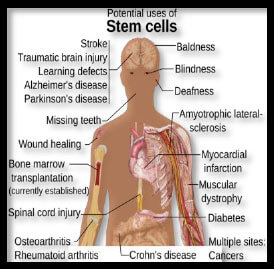Stem cells have the potential to generate different cell types in our body. They are undifferentiated cells and have the self renewal capacity. Under certain physiological or experimental conditions, stem cells can be induced to become tissue or organ-specific cells with stipulated functions.
Owing to their properties, stem cells can be manipulated and used for therapeutic purposes, called stem cell therapy. During an organ damage or tissue injury, there arises a need for organ or tissue replacement. To assure “transplantability” of donor tissue, stem cells can be directed to differentiate into specific cell type which matches the damaged tissue type and its functional characteristic to replace it eventually. Such a process offers a renewable source of replacement cells and tissue to treat diseases like spinal cord injury, diabetes, cardio-vascular diseases, bone marrow regeneration etc. Studies on embryonic stem cells reveal that it is possible to direct the differentiation of human embryonic stem cells in cell culture system to form insulin-producing cells that eventually could be used for transplantation therapy for diabetic patients. Stem cells also have potential application in transplantation procedures to restore blood forming Haematopoietic Stem cells (HSCs). Cancer patients whose bone marrow has been damaged by high dose of chemotherapy and radiation therapy, stem cell therapy might help such patients to recover his/her ability to produce normal and functional blood cells.

The process of stem cell therapy has certain challenges. The first difficulty in stem cell therapy is unavailability of optimum number of desired cells that is required to be grafted. In current cell therapy, grafting of pancreatic cells or hepatocytes is carried out using human cadaver donors, which generally limits the cell supply. The next problem of cell therapy is of graft-versus-host rejection. Grafting tissue from one individual to another (allogenic graft) provokes immune response by T-lymphocytes of the host cells. This immune reaction can be suppressed by the use of immunosuppressive drugs, but these drugs are known to cause organ damage. Moreover, an immunosuppressive drug makes the person sensitive to common infections which may worsen the outcome of the treatment. Thus the challenge of stem-cell therapy is to produce cells/tissues/organs that require no immunosuppressant. The third problem of cell therapy is effective delivery of graft cells. During cell therapy of heart and spinal cord it is usual to inject cells as suspension into the region of the damaged tissue. But animal experiments suggest that most of the cells die soon after injection. The key to this problem is to produce and culture cells into a particular three dimensional tissue configuration, which can be grafted as an integrated whole rather than being injected as cells.
Stem cell therapy has a considerable therapeutic potential. There are some areas that need to be improvised which demands research so that stem cell therapy can be looked upon as promising treatment for diseases and can be available for the betterment of mankind.









